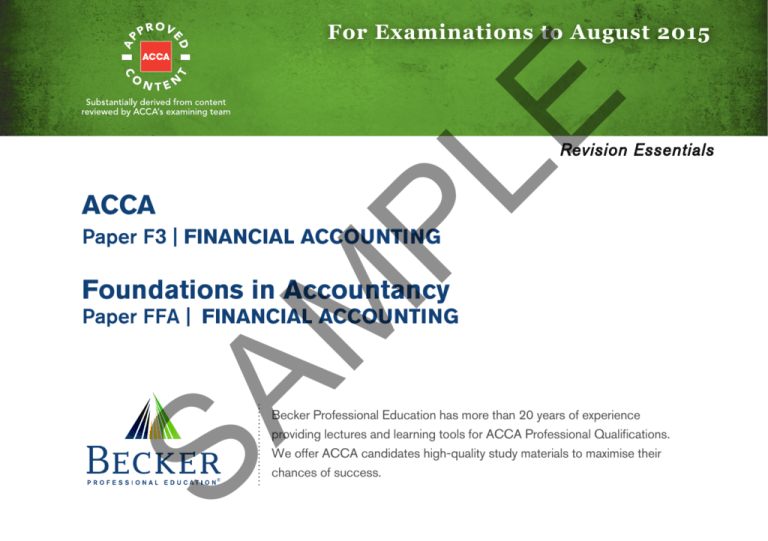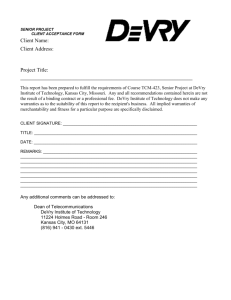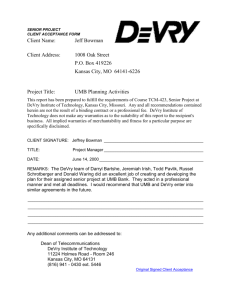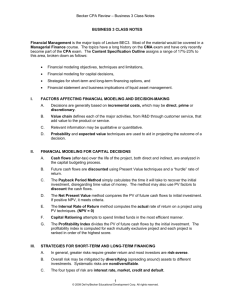
E
For Examinations to August 2015
PL
Revision Essentials
ACCA
Paper F3 | FINANCIAL ACCOUNTING
M
Foundations in Accountancy
SA
Paper FFA | FINANCIAL ACCOUNTING
®
Becker Professional Education has more than 20 years of experience
providing lectures and learning tools for ACCA Professional Qualifications.
We offer ACCA candidates high-quality study materials to maximise their
chances of success.
Becker Professional Education, a global leader in professional education, has been developing study materials for ACCA for more than
20 years, and thousands of candidates studying for the ACCA Qualification have succeeded in their professional examinations through its
Platinum and Gold ALP training centers in Central and Eastern Europe and Central Asia.*
E
Becker Professional Education has also been awarded ACCA Approved Content Provider Status for materials for the Diploma in International
Financial Reporting (DipIFR).
Nearly half a million professionals have advanced their careers through Becker Professional Education's courses. Throughout its more than
50-year history, Becker has earned a strong track record of student success through world-class teaching, curriculum and learning tools.
PL
We provide a single destination for individuals and companies in need of global accounting certifications and continuing professional education.
*Platinum – Moscow, Russia and Kiev, Ukraine. Gold – Almaty, Kazakhstan
Becker Professional Education's ACCA Study Materials
All of Becker’s materials are authored by experienced ACCA lecturers and are used in the delivery of classroom courses.
M
Study System: Gives complete coverage of the syllabus with a focus on learning outcomes. It is designed to be used both as a reference text
and as part of integrated study. It also includes the ACCA Syllabus and Study Guide, exam advice and commentaries and a Study Question
Bank containing practice questions relating to each topic covered.
Revision Question Bank: Exam style and standard questions together with comprehensive answers to support and prepare students for their
exams. The Revision Question Bank also includes past examination questions (updated where relevant), model answers and alternative solutions
and tutorial notes.
SA
Revision Essentials*: A condensed, easy-to-use aid to revision containing essential technical content and exam guidance.
*Revision Essentials are substantially derived from content reviewed by ACCA’s examining team.
®
E
M
PL
ACCA
PAPER F3/FFA
FINANCIAL ACCOUNTING
REVISION ESSENTIALS
SA
For Examinations to August 2015
®
E
No responsibility for loss occasioned to any person acting or refraining from action as a result of any material in this
publication can be accepted by the author, editor or publisher.
16 Elmtree Road
Teddington
TW11 8ST
United Kingdom.
M
PL
This training material has been published and prepared by Becker Professional Development International Limited.
ISBN-13: 978-1-78566-011-5
Copyright ©2014 DeVry/Becker Educational Development Corp. All rights reserved.
SA
All rights reserved. No part of this training material may be translated, reprinted or reproduced or utilised in any form either in
whole or in part or by any electronic, mechanical or other means, now known or hereafter invented, including photocopying
and recording, or in any information storage and retrieval system. Request for permission or further information should be
addressed to the Permissions Department, DeVry/Becker Educational Development Corp.
These are condensed notes focusing on key issues for those of you who lead busy, mobile
lives or for those of you who want to revise in a more focused fashion.
CONTENTS
Page
E
CONTENTS
Syllabus
Core topics
Examinable docs
Exam technique
M
PL
Approach to examining
(iv)
(v)
(vi)
(vii)
(viii)
Context of financial reporting
0101
Financial statements
0201
Accounting systems
0301
Double entry bookkeeping principles
0401
Ledger accounts
0501
Credit transactions
Trial balance
SA
Accruals and prepayments
0601
0701
0801
Depreciation and disposals
0901
Receivables and payables
1001
Inventory
1101
©2014 DeVry/Becker Educational Development Corp. All rights reserved.
(i)
CONTENTS
Page
E
CONTENTS
Books of prime entry and control accounts
1201
Control account reconciliations
1301
Suspense accounts
Incomplete records
Regulatory framework
Conceptual Framework
1401
M
PL
Bank reconciliations
1501
1601
1701
1801
IAS 1 Presentation of Financial Statements
1901
Capital structure and finance costs
2001
IAS 2 Inventories
2101
IAS 18 Revenue
2201
2301
IAS 38 Intangible Assets
2401
SA
IAS 16 Property, Plant and Equipment
IAS 37 Provisions, Contingent Liabilities and Contingent Assets
2501
IAS 10 Events After the Reporting Period
2601
IAS 7 Statement of Cash Flows
2701
©2014 DeVry/Becker Educational Development Corp. All rights reserved.
(ii)
CONTENTS
Page
E
CONTENTS
Consolidated financial statements
2801
Further consolidation considerations
2901
Additional reading
3001
M
PL
Interpretation of financial statements
Examiner’s comments – June 2014
SA
CAUTION: These notes only offer guidance on key issues.
On their own they are not enough to pass the examination.
©2014 DeVry/Becker Educational Development Corp. All rights reserved.
(iii)
3101
3201
SYLLABUS
Position of the paper in the overall syllabus
E
Aim
To develop knowledge and understanding of underlying
principles and concepts relating to financial accounting and
technical proficiency in the use of double-entry accounting
techniques including preparation of basic financial
statements.
F7
M
PL
Main capabilities
P2
On successful completion, candidates should be able to:
explain the context and purpose of financial reporting;
define qualitative characteristics of financial
information;
demonstrate use of double-entry and accounting
systems;
record transactions and events;
prepare a trial balance (including identifying and
correcting errors);
SA
prepare basic financial statements for incorporated and
unincorporated entities;
prepare simple consolidated financial statements;
interpret financial statements.
©2014 DeVry/Becker Educational Development Corp. All rights reserved.
FIA
FFA
FA2
FA1
(iv)
F3
ACCA
CORE TOPICS
CORE TOPICS
Tick when completed
E
Tick when completed
Incomplete records
Regulatory framework
Conceptual Framework
Context and purpose
Financial statements
Accounting systems
Book-keeping principles
Presentation of financial statements
Ledger accounts
Capital structure and finance costs
Sales and purchases
Inventories
Trial balance
Revenue
Accruals and prepayments
Property, plant and equipment
Depreciation and disposals
Intangible assets
Receivables and payables
Provisions and contingencies
Inventory
Events after the reporting period
Books of prime entry
Statements of cash flows
Control accounts and reconciliations
Consolidated financial statements
Bank reconciliations
Interpretation of financial statements
Suspense accounts
SA
M
PL
©2014 DeVry/Becker Educational Development Corp. All rights reserved.
(v)
EXAMINABLE DOUMENTS
1st February 2014 until 31st August 2015
ACCA Examination
Documents listed as being examinable are the latest that were
issued prior to 30th September 2013:
E
Approach to examining
A 2 hour paper-based or computer-based examination
(CBE).
IAS 1
Presentation of Financial Statements
Section A: 35 two-mark objective questions (“MCQs”)
IAS 2
Inventories
Section B: two 15-mark multi-task questions
(“MTQs”).
IAS 7
Statement of Cash Flows
IAS 10
Events After the Reporting Period
IAS 16
Property, Plant and Equipment
IAS 18
Revenue
IAS 27
Separate Financial Statements
IAS 28
Investments in Associates
IAS 37
Provisions, Contingent Liabilities and Contingent
Assets
IAS 38
Intangible Assets
IFRS 3
Business Combinations
IFRS 10
Consolidated Financial Statements
Consolidations (may include interpretation)
Accounts preparation (for sole trader or limited
company)
Both computational and non-computational elements.
SA
M
PL
©2014 DeVry/Becker Educational Development Corp. All rights reserved.
Other
Conceptual Framework for Financial Reporting
(vi)
EXAMINATION TECHNIQUE
Exam tips2
General
Allocate your time. On average:
MCQ 2-mark Qs 2½ minutes
MTQ 15-mark Qs 18 minutes
Answer all questions.
Cover up answers A, B, C, D while making
calculations.
MCQs mostly consist of1:
When time is up, guess! But avoid the least plausiblelooking answer (e.g. a disproportionate amount).
Multi-task questions (MTQs)
a “stem” (the question)
a “key” (the correct answer)
3 “distracters” (plausible but incorrect answers).
Some 1-mark MCQs have only 2 distracters or are
“true/false” type.
SA
1
correction of errors
journal entries
ledger control accounts
bank reconciliations.
Multiple choice questions (MCQs)
Double entry skills will be tested on, for example:
M
PL
E
EXAMINATION TECHNIQUE
See additional reading section for different types of MCQ
encountered in computer-based exams.
©2014 DeVry/Becker Educational Development Corp. All rights reserved.
Read requirement(s) carefully and highlight
“instruction” and “content”.
Remember: For longer Qs (and parts thereof) the first
marks are easiest so always move on to next Q when
time allocation is up.
2
(vii)
See also Examiner’s Report – June 2014 section.
EXAMINATION TECHNIQUE
Presentation
may be for any entity (sole trader, incorporated or
consolidated).
In paper-based exams:
Set out a clear pro-forma with relevant captions
(only);
Use a columnar layout;
Show all workings and cross-reference;
NEVER “finish” or “tidy up” when time is up.
Is important in paper-based exams!
Use only black ink.
Use headings, subheadings and underline with a ruler.
Do not use tipp-ex.
Show all workings and cross-reference.
Do not underline “key words”
Non-computational questions
Do not write an essay!
Jot down relevant ideas on an answer plan.
Use subheadings to address what is being asked for.
Bullet points (but not “note form”) are easiest to mark.
Work to 1 mark per relevant point clearly made.
“Explain …”
SA
E
Financial statements (or extracts):
M
PL
Give justification
Define terms
Use illustrations or examples.
©2014 DeVry/Becker Educational Development Corp. All rights reserved.
(viii)
CONTEXT OF FINANCIAL REPORTING
1.2 Sole trader
ENTITIES
1.1 Types
Sole trader
(“selfemployed”)
Controls, manages
and owns business.
Legally, person and
business are same.
Partnership
(“self
employed)
Incorporated
(“Company”)
Bears all financial
risks.
personal transactions
apportion business/private use of assets.
Profits shared by
agreement.
Almost complete control.
Low administration costs.
Few legal requirements.
Owned by
shareholders.
All personal assets at risk. Risk of bankruptcy.
1.3 Partnership
Run by appointed
directors.
©2014 DeVry/Becker Educational Development Corp. All rights reserved.
Disadvantages
Separate legal entity.
Subject to company
law.
Wholly liable for debts, etc.
Advantages
2+ people.
SA
Simple
Obliged to keep records:
M
PL
E
1
Obligations as for a sole trader.
Liabilities – as for a sole trader but shared jointly (even
if profits not equal).
Complex
0101
CONTEXT OF FINANCIAL REPORTING
Liabilities
More money can usually be raised for start-up.
Few legal requirements.
Workload can be shared.
To taxation (on all profits).
Share capital determines limit of shareholders’ liability.
Advantages
Directors protected from legal actions (if act in good
faith).
M
PL
Disadvantages
E
Advantages
Risk of personal bankruptcy.
Disadvantages
Need for joint decisions may hamper business.
Potential for conflict risk.
Much more administration.
Director has employee status (may be tax disadvantages).
Business affairs not private.
2
FINANCIAL REPORTING
1.4 Limited company
Obligations
Must hold an Annual General Meeting (AGM):
to receive/approve Annual Reports
to appoint directors and auditors.
To meet legal filing requirements.
To have at least one director.
In UK (for example) to have a company secretary.
SA
©2014 DeVry/Becker Educational Development Corp. All rights reserved.
Definition
Collection, analysis, summarization and presentation of
financial performance of a business.
2.1 Meaning
Classification and recording Bookkeeping.
Preparation of financial statements Accounting.
Presentation and disclosure in accordance with a
financial reporting framework Reporting.
0102
CONTEXT OF FINANCIAL REPORTING
FINANCIAL
ACCOUNTING
FINANCIAL STATEMENTS
Summarise
FINANCIAL
STATEMENTS
3.1 Components
Statement of financial position (“SoFP”.
Statement of comprehensive income (“SoCI”):
INFORMATION
SA
2.2 Bookkeeping
Collecting/recording of transactions (daily)
Collating/summarizing/balancing (e.g. monthly)
Making year-end adjustments.
M
PL
3
BOOKKEEPING
Activities:
E
“Systematic recording of financial transactions of a
business”.
Statement of changes in equity (“SoCIE”).
Statement of cash flows (“CFS”).
Accounting policies and explanatory notes.
Non-financial statements
Purpose – to record every financial transaction.
©2014 DeVry/Becker Educational Development Corp. All rights reserved.
statement of profit or loss (“income statement”);
other comprehensive income (e.g. gains and
losses).
0103
May be included in annual report (e.g. Chairman’s
statement, environmental reports).
CONTEXT OF FINANCIAL REPORTING
4.2 Information needs
To provide information about:
Financial position (e.g. solvency) SoFP
Financial performance (e.g. profitability) SoCI
Cash flows CFS
To show results of management’s stewardship
(“accountability”).
3.3
Inter-relationship
OPENING
SOFP
4
USERS
4.1 Types
+
SOCI
Shareholders
For decision-making
To assess dividends
Management
To plan and control operations
To make financial analysis
M
PL
E
3.2 Purpose
+
CHANGES IN
EQUITY
=
CLOSING
SOFP
Internal (e.g. owners, employees).
External (e.g. potential investors, banks, government).
SA
©2014 DeVry/Becker Educational Development Corp. All rights reserved.
Employees
Stability and profitability
Remuneration, pension
For collective bargaining
Prospective
investors
To assess risks and returns
Financial
institutions
Providing loan facilities
Repayments scheduling
Suppliers
Ability to pay on time
Security (assets)
Customers
Continuity of supply
Government
Taxation regulation
National statistics
Public and media
Contribution to local economy
Recent developments.
0104
FINANCIAL STATEMENTS
STATEMENT OF FINANCIAL POSITION
Definition
1.1 Description
M
PL
Reports assets, liabilities and equity at a date.
A statement of carrying amounts (“book” values).
Vertical format.
All items have monetary value.
1.2 Presentation
Statement of Financial Position as at …
ASSETS
$
$
Non-current assets
Cost Depreciation
Intangible assets
x
x
Property, plant and
x
x
equipment
x
x
Current assets
Inventories
x
Trade and other receivables
x
Prepayments
x
Cash
x
E
1
Assets/liabilities grouped in classifications.
Minimum requirements for IFRS (e.g. for companies)
are set out in IAS 1 (Session 19).
SA
1.3 Proforma – Sole trader
©2014 DeVry/Becker Educational Development Corp. All rights reserved.
Total assets
CAPITAL AND LIABILITIES
Capital and reserves
Capital b/fwd
Profit/(loss)
Drawings
Capital c/fwd
Non-current liabilities
Long-term borrowings
Current liabilities
Trade and other payables
Accrued expenses
Operating overdrafts
Total capital and liabilities
0201
x
x
(x)
$
x
x
x
x
x
x
x
x
x
x
x
x
FINANCIAL STATEMENTS
ASSETS
Cash
Definition
Economic resource controlled … has future economic
benefit … is result of past financial transaction.
Receivables
Presented in increasing liquidity order: inventory,
receivable, cash.
Tangible (physical).
Intangible (without physical substance).
Goods for resale/ Raw materials/WIP.
Initially recorded at “cost”.
Measured at lower of:
Wearing out (depreciation/amortisation).
Investments
Inventory
M
PL
2.1 Non-current
E
2
Inventory
Cost (i.e. purchase price/manufacturing cost); and
Net realisable value (estimated selling price –
further costs).
Usually shares in/loans to other entities.
May be non-current or current.
Receivables
“Listed” means quoted on a recognised stock exchange.
Owe the entity money.
Carrying amount is net of allowance for nonrecoverability.
SA
2.2 Current
Acquired for conversion into cash in ordinary course of
business.
Prepayments
Expect to hold < 1 year.
©2014 DeVry/Becker Educational Development Corp. All rights reserved.
0202
Amounts paid on or/before end of reporting period
relating to a later period.
FINANCIAL STATEMENTS
Cheques, bank notes, coins and “demand” deposits.
“Petty” cash.
3
LIABILITIES
trade payables (to suppliers);
“overdrawn” bank account.
Accrued expenses
M
PL
Total assets – Total liabilities = Capital and reserves
(shareholders’ “funds”)
Amounts owed due for payment < 1 year after year end:
2.3 Net assets
E
Current
Cash
Amounts invoiced after the year end for goods/services
provided before the year end.
The “opposite” of prepayments.
Financial obligation (or cash required to satisfy contractual
terms of such an obligation).
4
STATEMENT OF COMPREHENSIVE INCOME
Implies legal responsibilities to other parties:
Definition
4.1 Presentation
External (e.g. suppliers and employees).
Non-current
Loans (usually interest-bearing).
Provisions falling due > 1 year.
Others (e.g. pension liabilities, deferred tax) are exsyllabus.
SA
©2014 DeVry/Becker Educational Development Corp. All rights reserved.
Either:
Single statement of comprehensive income; or
Two statements:
(1)
(2)
0203
profit or loss; and
other comprehensive income.
FINANCIAL STATEMENTS
4.2 Profit or loss
E
Trading account (Revenue – Cost of sales = Gross
profit)
Income and expenditure (“profit and loss”) account
(all other items of income and expenditure).
Shows profit or loss for period before other
comprehensive income.
4.3 Other comprehensive income
STATEMENT OF PROFIT OR LOSS
FOR THE YEAR ENDED …
$
Summarises financial operations for a specific period of
time:
Revenue
Less:
Cost of sales
Opening inventory
Add: Purchases
Less: Closing inventory
M
PL
Other items of income and expense not recognised in
profit or loss!
Only a surplus arising on revaluation of a property is
examinable in F3.
SA
Note, for manufacturing entity cost of goods sold =
manufacturing cost:
___
(x)
___
Gross profit
x
Other operating income
Less: Expenses
Distribution costs
Administrative expenses
x
Profit for the year
Raw materials + production labour + overheads
©2014 DeVry/Becker Educational Development Corp. All rights reserved.
x
x
(x)
= Cost of goods sold
4.4 Proforma – Sole trader
$
x
0204
x
x
___
(x)
___
x
___
FINANCIAL STATEMENTS
Profit measures:
5
Gross profit margin:
Gross profit
Revenue
100
Revenue (“turnover”)
Deducted from cost of sales/included in inventory (an
asset) – will be expense next year.
INTER-RELATIONSHIP
5.1 Between SoFP and SoCI
M
PL
Gross profit – calculated in Trading account
Profit or loss (“net income”) – calculated in Profit
and loss account.
Counted and valued (normally at cost).
E
4.5 Trading account
SoPF – a “snapshot”.
SoCI – a “movie”.
5.2 Capital v revenue expenditure
Capital expenditure
Reflects all sales made to customers.
A sale is usually recognised when goods
despatched/services rendered.
SoFP
Acquiring non-current assets.
Sales made but not paid for = Trade receivables.
Increases revenue-earning capacity.
Ultimately expensed to profit or loss (through
depreciation).
Except cost of land.
Cost of sales
Cost of goods actually sold = all costs associated with
purchase/manufacture.
Costs are “matched” with revenues earned.
Revenue expenditure
SA
Closing inventory
Profit or loss
Incurred in daily running of business.
Inventory held at the end of a trading period.
©2014 DeVry/Becker Educational Development Corp. All rights reserved.
0205
ACCOUNTING SYSTEMS
Internal controls ensure
ACCOUNTING SYSTEMS
1.1 Qualities of useful information
Relevant
Complete
Objective
Cost effective
Concise
Transactions are authorised (i.e. valid).
All transactions and other events are recorded promptly,
accurately and completely.
Access to assets and records is restricted.
Recorded assets exist.
M
PL
Records and procedures, formal and informal, relating to the
assembling, recording, retrieval and reporting of financial
information that also provide necessary internal controls.
E
1
Reliable
Accurate
Comparable
User-friendly
Timely.
1.3 Accounting records
All records of monetary transactions, assets and liabilities
(includes books of prime entry, ledgers, documentation).
2
SALES
1.2 Organisational objectives
2.1 Documentation
SA
Orderly and efficient business conduct.
Adherence to management policies.
Safeguarding of assets.
Prevention/detection of fraud/error.
Accuracy and completeness of accounting records.
Timely preparation of reliable financial information.
©2014 DeVry/Becker Educational Development Corp. All rights reserved.
Customer order (oral/written).
Quotation for bulk discounts, customised products.
In “standard form”
Sales order (SO) – customer, product(s), quantities
prices.
Goods despatch note (GDN) – SO + delivery details.
Sales invoice – GDN details + prices + tax.
Customer statement (extracted from receivables ledger).
0301
ACCOUNTING SYSTEMS
Received from supplier
Sales invoice in SDB
D/E from SDB
Trade receivables
Cr Revenue
$x
$x
Credit notes to customer (in SDB or returns book)
Dr
Revenue
Cr Trade receivables
2.3 Reconciliation
Credit note (e.g. for goods returns).
Supplier’s statement (extracted from supplier’s
receivables ledger).
3.2 Recording
$x
List of receivables ledger balances to control a/c
3
PURCHASES/EXPENSES
3.1 Documentation
Purchase invoice – product(s), quantities, prices + tax.
M
PL
Dr
E
2.2 Recording
$x
Purchase invoice in PDB
D/E from PDB
Dr
Purchases/expenses
Cr Trade payables
$x
$x
Credit note in PDB (or purchases returns)
Dr
Trade receivables
Cr Purchases/expenses
$x
In “standard written form”
Purchase requisition.
SA
Purchase order (PO) – supplier, product(s), quantities
(may be + prices also).
Goods/services received note (GRN) – PO details +
delivery details.
©2014 DeVry/Becker Educational Development Corp. All rights reserved.
3.3 Reconciliations
Individual payables ledger balances to supplier’s
statement.
List of payables ledger balances to control a/c.
0302
$x
ACCOUNTING SYSTEMS
4.3 Reconciliation
CASH
E
4
4.1 Documentation
Receipts
5
Remittance advice (accompanying receipt from
customer).
5.1 Documentation
Cash (cheque, bank order/transfer).
Received
Cash in cash book.
D/E from cash book.
5.2 Recording
$x
$x
SA
Cash
Cr Receivables
Payments
Dr
Goods despatch note (GRN).
On “bin card” or other inventory records.
4.3 Reconciliation
Receipts
Dr
Advice/delivery note (from supplier).
Goods received note (GRN).
Despatched
Payment requisition.
Cash (cheque, bank order/transfer).
4.2 Recording
INVENTORY
M
PL
Payments
Cash book balance to bank statement.
Payables
Cr Cash
$x
©2014 DeVry/Becker Educational Development Corp. All rights reserved.
$x
0303
Quantities on inventory records to physical balances.
ACCOUNTING SYSTEMS
TANGIBLE NON-CURRENT ASSETS
E
6
6.1 Documentation
Purchase
Capital expenditure requisition.
Other as for purchases.
Disposal
Authority to dispose (scrap/sell/part-exchange).
Sales invoice.
6.2 Recording
Purchase/sales invoice in PDB/SDB.
Cash paid/received in cash book.
Asset register.
6.3 Reconciliation
Items in asset register to physical assets.
SA
M
PL
©2014 DeVry/Becker Educational Development Corp. All rights reserved.
0304
DOUBLE-ENTRY BOOKKEEPING PRINCIPLES
2
ACCOUNTING CONVENTIONS
BUSINESS ENTITY CONCEPT
E
1
Definition
BASIC
PRINCIPLES
M
PL
BUSINESS
ENTITY
Accounting applies to a business entity that is separate
and distinct from its owner(s).
“DUALITY”
ACCOUNTING
EQUATION
Business entity may be legally separated from owners.
If not legally distinguishable must be distinct from
owners for accounting purposes.
Transactions between an entity and its owners are
separately identified and accounted for from entity’s
perspective.
3
DUALITY
Definition
SA
Every transaction has a dual effect.
©2014 DeVry/Becker Educational Development Corp. All rights reserved.
Second effect is equal to and “opposite” to the first.
All effects are considered from entity’s perspective.
0401
DOUBLE-ENTRY BOOKKEEPING PRINCIPLES
Components
ACCOUNTING EQUATION
4.1 The principle
At any point in time:
Capital: investment by the owner(s);
Retained earnings (“accumulated profits”): profits less
losses earned and retained.
Appropriations to owners:
M
PL
Net assets (i.e. Assets – Liabilities) = Equity
E
4
Consequently, a change in net assets must equal change
in equity in any period:
Closing – Opening = Capital introduced + Profit – Appropriations
net assets net assets
in period
– Loss (e.g. distributions)
“drawings” by sole traders (money/goods);
salaries and profit shares (to partners);
distributions (“dividends”) to shareholders.
4.3 The equation
4.2 Equity
Definition
Assets = Equity + Liabilities
Residual interest in assets after deducting all liabilities.
SA
A “Framework” definition
©2014 DeVry/Becker Educational Development Corp. All rights reserved.
Underlies presentation of statement of financial position
(also called “balance sheet”):
0402
LEDGER ACCOUNTS
LEDGER ACCOUNTS
E
1
STAGES
1.1 Double entry bookkeeping
TRANSACTIONS
Based on concept of “dual effect”.
Every debit has a matching credit (and vice versa).
One account for each type of transaction.
Depicted as “T” accounts.
M
PL
(1) LEDGER
A/Cs
Convention
Dr (left)
Cr (right)
“Balance sheet” * a/c
(2) BALANCE
A/Cs
Period-end
adjustments
(see later)
SA
(4) CLOSE
BOOKS
Dr entry represents
(3) TRIAL
BALANCE
or
1
ASSET
2
LIABILITY
1
LIABILITY or
2
ASSET
* Remember this is common name for SoFP.
I&E a/c
Dr entry represents
DRAFT
ACCOUNTS
©2014 DeVry/Becker Educational Development Corp. All rights reserved.
Cr entry represents
0501
Cr entry represents
1
EXPENSE
or
1
INCOME
or
2
INCOME
2
EXPENSE
LEDGER ACCOUNTS
3
BALANCING ACCOUNTS
TRIAL BALANCE
E
2
2.1 Purpose
3.1 Extracting a list of balances
Helps ensure D/E recorded correctly.
Means to “strike (i.e. arrive at) a balance”.
Balancing amounts inserted are:
Carried down (“c/d”) or forward (“c/f”)
Brought down (“b/d”) or forward (“b/f”).
Can be done at any time.
Always done before books are “closed”.
2.2 Procedure
Links ledger a/cs financial statements.
M
PL
Simply a list of all Dr and all Cr balances on individual
ledger a/cs.
(2)
Write the larger amount as total on both sides.
(3)
Insert balancing figure (“c/fwd”) so both sides are equal
SA
Cast (i.e. sum) Dr side and note total.
Cast Cr side and note total.
Drs > Crs Dr balance
b/fwd on Dr side of a/c.
(b)
Crs > Drs Cr balance
b/fwd on Cr side of a/c
©2014 DeVry/Becker Educational Development Corp. All rights reserved.
Balances can be extracted (i.e. listed) at any time.
Always done as at the end of a reporting period.
4
CLOSING THE BOOKS
4.1 Two types of account
(1)
(a)
I&E a/cs – these are “closed off” (totals transferred to
profit and loss a/c).
Asset and liability a/cs – closing balances are simply
b/d as opening balances (in next accounting period).
0502
CREDIT TRANSACTIONS
CREDIT TRANSACTIONS
2
DISCOUNTS
E
1
1.1 Credit sale
2.1 Trade
On sale:
Dr
Trade receivable
Cr
Sales
On receipt of cash:
D/E
Dr
Cash
Cr
Trade receivable
1.2 Credit purchase
On purchase:
D/E
Dr
Purchases
Cr
Trade payable
On payment of cash:
Dr
Trade payable
Cr
Cash
SA
D/E
Original sale/purchase is recorded at net amount (after
discount).
M
PL
D/E
Price reductions to trade customers.
©2014 DeVry/Becker Educational Development Corp. All rights reserved.
Also called “bulk” and “volume” discounts.
2.2 Settlement
Offered for prompt/early payment (settlement).
Original sale/purchase is recorded at gross amount
(before discount).
Allowed – to customers
Decrease in receivable is an expense:
D/E
Discount allowed (I&E) a/c
Cr
Trade receivable
$x
$x
Statement of profit or loss for a sole trader may show:
0601
Dr
gross revenue and discounts allowed separately;
net revenue (i.e. net of discounts).
CREDIT TRANSACTIONS
3.2 Purchases (Returns out)
Decrease in payable is decrease in expense:
3
Dr
3.1 Sales (Returns in)
D/E
Trade payables a/c
$x
Cr
Discounts received (I&E) a/c $x
RETURNS
Dr
Sales returns (or Revenue)
Cr
Trade receivables
Reduce amount to be received.
If cash refunded:
Dr
Trade receivables
Cr
Cash
SA
D/E
Dr
Trade payables
Cr
Purchase returns (or Purchases)
A cash refund.
©2014 DeVry/Becker Educational Development Corp. All rights reserved.
If cash refunded:
D/E
On issue of credit note:
D/E
On receipt of credit note:
M
PL
D/E
E
Received – from suppliers
0602
Dr
Cash
Cr
Trade payables
TRIAL BALANCE
Questions answered
ROLE
?
1.1 Nature
List of all Dr and all Cr balances on individual ledger
accounts.
?
Expect balances to be:
?
?
1.2
Dr – asset and expense a/cs
Cr – liability and income a/cs.
No prescribed order. Examples:
alphabetically by name;
order of appearance in financial statements.
Purposes
Is D/E correct in principle? (i.e. every Dr has
equivalent Cr?)
Has every ledger account been correctly cast?
Have balances been correctly calculated and recorded in
the correct Dr/Cr column?
M
PL
E
1
(1) To assist in detection of bookkeeping errors.
SA
(2) To prepare accounts via extended trial balance (ETB).
©2014 DeVry/Becker Educational Development Corp. All rights reserved.
Have Dr and Cr columns of TB been added up
correctly?
Advantages
Agreed TB provides prima facie evidence of arithmetic
accuracy of “books of account”.
Errors revealed can be corrected before financial
statements are drafted.
Limitations
Does not prove accuracy of allocation/classification
and recording.
Does not prove completeness (i.e. no omissions).
0701
TRIAL BALANCE
ERROR DETECTION
3
FINANCIAL STATEMENTS PREPARATION
E
2
2.1 Types of error
3.1 Extended Trial Balance (ETB)
Identified
Because ∑Drs ≠ ∑Crs.
TB can be extracted any time.
M
PL
Financial accounts prepared at period end via ETB.
ETB is a “work sheet” which makes adjustments:
Single-sided, unequal and double-sided entries.
Casting errors in ledger a/cs.
Balances b/fwd on “wrong side” of ledger a/cs.
Period-end adjustments
Ledger a/c balances omitted when extracting.
Transposition errors ( 9).
Errors not identified
Original (prime) entry – initial recording at wrong
amount.
Omission – transaction not recorded.
Commission (“carelessness”) – misclassification (but
not “in principle”).
Principle – revenue items as capital (or vice versa).
Compensating – neutralisation by equivalent opposite
error(s).
SA
©2014 DeVry/Becker Educational Development Corp. All rights reserved.
0702
to correct errors identified by TB
to account for period-end adjustments.
Accruals and prepayments.
Depreciation.
Allowance for irrecoverable debts.
Inventory.
ACCRUALS AND PREPAYMENTS
2
ACCRUAL BASIS
EXPENSES
E
1
1.1 Accruals concept
2.1 Traditional approach
Revenue and costs
Recognised as earned or incurred not when cash is
received/paid.
Recorded in periods to which they relate.
Assumption about timing.
Expenses
Paid in advance Prepaid expense (“Prepayment”)
Incurred but not paid Accrued expense
Income
Received in advance Deferred income
Earned but not paid Accrued income
SA
C/fwd accrual/prepayment (liability/asset on expense a/c)
Expense is balancing figure on “T” a/c.
Alternatively calculate expense c/fwd is balancing
figure – but above is usually easier.
Advantages
No need to maintain separate accrual/prepayment
accounts for balances.
Simpler (especially in manual systems).
2.2 Alternative/“reversal” approach
“Matching concept”
Expenses should be matched against revenue generated.
Use TWO “T” a/cs.
Calculate accrual/prepayment.
If prepaid:
D/E
Prudence concept
Calculate accrued expense/prepayment.
M
PL
1.1 Consequences
Use only ONE “T” a/c.
Future income cannot be recognised.
©2014 DeVry/Becker Educational Development Corp. All rights reserved.
0801
Dr
Prepayments a/c
Cr
Expense a/c
ACCRUALS AND PREPAYMENTS
If accrual:
Dr
Expense a/c
Cr
Accrued expense a/c
“Reverse” these period-end adjustments at beginning of
new accounting period.
2.3 Practicalities
A prepayment can be calculated (as the advance
payment is known amount).
An accrual is usually an accounting estimate.
Any difference between estimate and actual is Dr/Cr to
profit or loss in the following year’s expense.
Income a/c
Cr
Deferred income a/c
SA
Deferred
Income
Liability
3.2 Alternative/”reversal” approach
As for expenses but:
If accrued (“opposite” of accrued expense treatment):
©2014 DeVry/Becker Educational Development Corp. All rights reserved.
Accrued
Expense
Liability
4.2 Income
As for expenses but calculate accrued/deferred income.
SUMMARY OF ACCOUNTING EFFECTS
Prepaid
Asset
Expense
3.1 Traditional approach
Dr
4.1 Expenses
Exam Tip: It is unnecessary to “prove” charge to profit or
loss with a calculation.
INCOME
Accrued income a/c
Cr
Income a/c
If deferred (“opposite” of prepaid expense):
D/E
4
3
Dr
E
D/E
D/E
M
PL
Accrued
Asset
Income
(Deferred income is a liability if there is an obligation to
repay.)
0802
DEPRECIATION AND DISPOSALS
NON-CURRENT ASSETS
2
DEPRECIATION
E
1
Definition
2.1 Concept
Assets expected to be used during more than one accounting
period ...
Monetary assets with physical substance:
Property, plant and equipment;
Investments (excluding short-term).
1.2 Intangible assets (see section 23)
Non-monetary assets without physical substance:
Rights (e.g. copyrights, patented rights)
Manufacturing licences
Goodwill
Development costs
Brands.
SA
1.3 IAS 16 (see detail in section 22)
Principal issues
Apart from land assets wear out (time and use).
M
PL
1.1 Tangible
Only revenue expenditure (not capital expenditure) is
charged to profit or loss.
Asset recognition.
Determination of carrying amount.
Recognition of depreciation.
©2014 DeVry/Becker Educational Development Corp. All rights reserved.
Capital costs are “spread” and expensed over useful
lives (“matching concept”).
2.2 Definitions (simplified)
Property, plant and equipment – Tangible assets:
held for use in production/supply of goods/services (or
for admin)
expected to be used during > 12 months.
Depreciation – Systematic allocation of depreciable amount
over useful life.
Depreciable amount – Cost (or revalued amount) less
residual value.
Useful life – Period of time over which asset expected to be
used.
Cost – Amount of cash paid to acquire/construct.
0901
DEPRECIATION AND DISPOSALS
2.3 Methods
Generally based on:
Passage of time (e.g. straight-line, reducing
balance); or
Level of activity (e.g. units of production).
Straight line
Also called “reducing instalment”.
Progressively decreasing expense over useful life.
Used where consumption is highest initially.
M
PL
Carrying amount – Amount recognised in SoFP (after
deducting accumulated depreciation).
E
Reducing balance
Residual value – Net amount expected to be obtained at end
of useful life less expected disposal costs.
Residual value generally ignored.
Formula:
Carrying amount annual depreciation rate (%)
Advantages
Straight-line
Recognises “consumption” of benefits (through use) on
pro-rata basis.
Simple – “one-off”
annual calculation
Is “default basis” (i.e. if no pattern of consumption).
Constant expense
(does not distort)
Formula:
Easy to calculate
accumulated
depreciation (e.g.
annual charge × n
years).
Cost - Residual value *
SA
Useful life *
* Accounting estimates.
Expressed as:
“straight line over n years”; or
x% per year on cost.
©2014 DeVry/Becker Educational Development Corp. All rights reserved.
0902
Reducing balance
“Accelerated”
expense reflects
greater use in earlier
years
Assets in use never
fully depreciated.
No need to separately
identify assets (until
disposal).
DEPRECIATION AND DISPOSALS
Straight-line
Unrealistic (
consumption of
benefits)
No expense after
useful life (assets still
in use).
2.4 Ledger accounting
Asset cost a/c
Dr
Reducing balance
Calculations more
complex.
Balance c/fwd and b/fwd at end of each year is
increased by charge for year.
But see disposals (later).
Are not errors.
Change is reflected in depreciation expense of current
and future periods.
Exception is revaluation (see section 22).
Useful life
Depreciation is calculated on remaining life.
Formula (straight line):
Expense (charge) for year Dr.
Reduction in carrying amount Cr.
Depreciable amount
Entries:
Remaining useful life
SA
Dr
Depreciation expense a/c
Cr
Accumulated depreciation a/c
©2014 DeVry/Becker Educational Development Corp. All rights reserved.
$x
2.5 Changes in estimates
As long as asset is owned this shows original purchase
price (or cost of construction).
$x
Accumulated depreciation
Depreciation
Profit or loss (I&E a/c)
Cr
Depreciation expense a/c
M
PL
At end of reporting period:
E
Disadvantages
$x
$x
0903
DEPRECIATION AND DISPOSALS
Most likely to apply to straight line method.
A reduction in estimate (most likely) simply increases
depreciable amount.
3
DISPOSALS
3.1 Ledger accounting
D/E
Dr Disposals a/c
Cr I&E a/c
Loss on sale (= under depreciation)
Disposals a/c
Cr Asset a/c
Dr
Accumulated depreciation a/c $Accd depn
Cr Disposals a/c
$Accd depn
$Cost
$Cost
Trade-in allowance (X)
SA
Account for proceeds:
D/E
Cash (or receivable) a/c
Cr Disposals a/c
Cr Disposals a/c
3.2 Part exchange/ “trade-in”
Dr
Dr
Profit on sale (= over depreciation):
D/E
Dr I&E a/c
Transfer cost and accumulated depreciation to disposals
a/c:
D/E
M
PL
At end of year – transfer profit or loss on disposal (i.e.
balance on disposals a/c) to profit or loss (I&E a/c).
E
Residual value
= Proceeds on sale of
old asset
Dr Asset cost a/c
Cr Disposals a/c
In summary:
Dr
$x
$x
©2014 DeVry/Becker Educational Development Corp. All rights reserved.
= Part of cost of new
asset
0904
Asset a/c
Cr Cash (or bank) a/c
Cr Disposals a/c
$(X+Y)
$Y
$X
DEPRECIATION AND DISPOSALS
REVALUATION
Alternatives
E
4
4.1 Appreciating assets
For example property.
Carrying value = revaluation amount – subsequent
accumulated depreciation.
Gain is unrealised (i.e. not recognised in profit or loss).
D/E
Dr
Charge full year in year of
acquisition. None in year
of disposal.
M
PL
Asset
Cr Other comprehensive income
$
x
$
x
Gains are accumulated in a revaluation surplus in
SoCIE (see section 19).
5
PRACTICAL POINTS
Purchase date not specified NO choice but to charge
full year.
Always READ THE QUESTION.
Use one for each category of asset (with same
depreciation policy).
Advantage
Same method must be consistently applied to all similar
assets.
Usually from date brought into use (may be legal
requirement).
SA
Exam Tips:
5.2 Ledger accounts
5.1 Depreciation calculations
©2014 DeVry/Becker Educational Development Corp. All rights reserved.
Pro rata basis
(i.e. n months @ x%).
Assuming no residual values, calculate annual
depreciation on year-end balance (after accounting for
all additions and disposals).
Disadvantage
0905
If using straight line method, take care not to charge
depreciation on already fully-depreciated assets.
DEPRECIATION AND DISPOSALS
5.4 Fixed asset register
Assuming a full year’s charge in the year of purchase
and none in the year of sale.
Adjust cost and accumulated depreciation for
additions/disposals and calculate depreciation on
carrying amount.
SA
Date acquired
Original cost
Useful life
Residual value (if any)
Depreciation method
Distinguishing features (e.g. vehicle registration).
M
PL
Adjust cost for additions/disposals and calculate
depreciation on cost.
Reducing balance method
Simply a log of all tangible non-current assets:
Straight line method
E
5.3 Short-cut calculations
©2014 DeVry/Becker Educational Development Corp. All rights reserved.
Uses:
0906
calculating depreciation
identifying fully-depreciated assets
historic information to account for disposals
in periodic physical inspection (to ensure
existence).
E
PL
ABOUT BECKER PROFESSIONAL EDUCATION
Becker Professional Education provides a single destination
for candidates and professionals looking to advance their
careers and achieve success in:
Accounting
•
International Financial Reporting
•
Project Management
•
Continuing Professional Education
•
Healthcare
SA
M
•
For more information on how Becker Professional Education can
support you in your career, visit www.becker.com.
®
E
For Examinations to August 2015
M
ACCA syllabus aim and main capabilities
Core topics checklist
Summary of essential facts and theory
Further reading
Relevant articles
Comprehensive analysis of past examinations
Examiners' feedback for the last exam session
Exam technique
SA
•
•
•
•
•
•
•
•
PL
Revision Essentials includes:
www.becker.com/ACCA | acca@becker.com
©2015 DeVry/Becker Educational Development Corp. All rights reserved.
Revision Essentials are not quality assured by ACCA but their content is substantially derived from materials which have been quality assured by ACCA.






